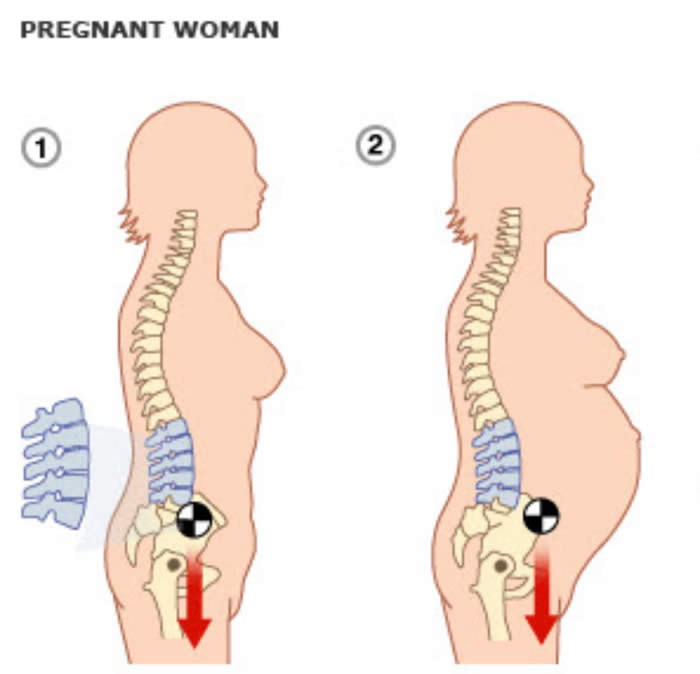March 2013
Incorporating NPI’s 4 Points of Posture™ During Pregnancy and Postpartum
By Alison B. Marsh, NPI-Certified Posture Specialist™
Pregnancy is an amazing phenomenon a woman’s body can endure and achieve. The natural change a woman’s body goes through during pregnancy in order to create another human being can be described as miraculous. Yet this miraculous phenomenon causes significant stress to the woman’s body, physically and emotionally. But with proper attention to these changes, the mom-to-be can enjoy the experience of pregnancy!
One of the most common problems in pregnancy is low back pain primarily caused by poor posture. Many factors contribute to the propensity for pregnant women to develop poor posture.
Hormones
The pregnant body is flooded with the hormones relaxin, progesterone, and estrogen of which purposefully relax joints, ligaments and muscles, making them more supple for the expanding uterus and the hips mobile for delivery. These hormones also make the rest of the body much more lax with a risk of overstretching the joints. Special attention must be taken when stretching during and after pregnancy (up to 9 months or until breast feeding stops), making sure to not overstretch ligaments, which have difficulty returning to normal laxity.
The hormone testosterone, responsible for coordination and balance, decreases in pregnancy making women more susceptible to clumsiness. With these hormonal changes, pregnant women are more prone to injury then non-pregnant women.

Shift of Center of Gravity (COG)
During pregnancy the women’s center of gravity shifts forward (see image 1). The weight of the growing uterus forces the pelvis into an exaggerated, anterior (back) tilt called Lordosis. This tilt is necessary for ease during the birth, but is taken to the extreme causing added stress on the pelvis, pubic symphysis, abdominals, and lumbar spine.
Upper Body Demands
The slumping forward of the shoulders due to the weight of the growing breasts is another common problem during pregnancy and postpartum. This causes the chin to poke forward resulting in Kyphosis, an exaggerated rounding of the thoracic spine. Postpartum, mom is now holding baby in front of her, possibly breast feeding, causing a frequent rounding of the shoulders.
Incorporating NPI’s 4 Points of Posture™ during pregnancy can help prevent Lordosis and Kyphosis, correct balance deviations, and help to stabilize core muscles reducing the risk of injury from falling and complications from the added weight by the growing fetus.
Here are the NPI’s 4 Points of Posture™ and how to incorporate them relating to the pregnant body.
1. Sit /Stand Up Straight and Tall - Creates space for the fetus to grow and takes unnecessary pressure off of the internal organs.
2. Hold Chest High - Allows for efficient intake of oxygen to the lungs, creating space for the expansion of the lungs.
3. Pencil Between the Shoulder Blades - Strengthens mid back muscles necessary for supporting upper body weight and opens the chest reducing tightness in the Pecs (chest muscles) and allowing for efficient intake of oxygen.
4. Contract Your Abdominals (Belly to the Spine)- Baby to the Spine or Hug the Baby is another term used to help mom utilize the transverse abdominals which wrap like a corset. The pelvic floor should be engaged in addition to the transverse abdominals.
Dr. Mehmet Oz (as seen on Oprah and Dr. Mike Roizen, renowned OBGYNs and authors of the book YOU: Having a Baby, share their expert advice on the importance of posture and core strength during pregnancy:
We recommend resistance-training exercises that focus on your core to help maintain some of that internal strength in your abdominal and lower back muscles that support your back. The earlier you start the better. Also, keeping an eye on your posture automatically builds the core muscles.
No matter where you are, think about lifting your head up and back, as if a string were pulling the top of your head toward the ceiling. As you lift up, you relieve some of the tension in your spine.
When working with pregnant clients, start by educating about proper posture and core strength. A healthy, pain-free pregnancy sets the stage for a healthy, happy baby and mommy.
Make A Difference-Improving Your Client’s Posture
Do you want to enhance your client’s/patient’s posture? A National Posture Institute-Certified Posture Specialist™ (CPS™) can help. Qualified NPI-Certified Posture Specialists assess their clients’ postural patterns and target abnormal patterns such as lordosis (abnormal inward or forward curvature of the vertebral column) and kyphosis (abnormal curvature of the spine, causing a hunchback). A postural assessment provides an objective means of identifying postural concerns and establishing a direction for appropriate exercise program design. To learn more, contact Ken Baldwin, Assistant Professor.
About the Author:
Alison B. Marsh is an NPI Certified Posture Specialist™ and a Pilates Instructor and Educator specializing in Pregnancy and Postnatal. She holds a Bachelor in Dance Education and a Bachelor in Social Work, and developed the DK Body Pregnancy Pilates Certification for Pilates instructors and health and fitness specialists.
Alison has been teaching Pilates for 12 years and is the owner of AM Pilates and Posture in Las Vegas, NV. She lives in Las Vegas with her husband and 4 children.
 |
Contact Alison B. Marsh:
702-339-2809
alisonb.marsh@yahoo.com
515 Rose St., Las Vegas, NV 89106 |
References:
Carolyne Anthony.The Pilates Way to Birth. The Center for Women’s Fitness by Carolyne Anthony, 2008.
James F. Clapp. Exercising Through Your Pregnancy. Omaha, Nebraska. Addicus Books, Inc., 2002.
Mehmet C. Oz, M.D. and Michael F. Roizen, M.D. You: Having a Baby. New York, NY. Free Press, 2009
Image 1- Center of Gravity shift in Pregnancy
http://www.squidoo.com/pregancybackpain?utm_source=google&utm_medium=imgres&utm_campaign=framebuster |
